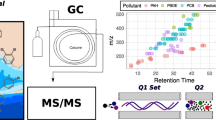Abstract
A comprehensive analytical method for nearly 1000 semi-volatile organic compounds (SVOC) in sediments has been developed using an automated identification and quantification system with a GC-MS database. The results of recovery tests using model compounds, which comprise of 119 non-polar to polar compounds, showed that the method can quantitatively analyze most SVOC, except for very polar substances. Analytical results of a standard reference material were close to certified concentrations. The detection limits of the method were 4 μg/kg when measuring by TIM and 0.4 μg/kg by SIM. The method was applied to actual sediments in rivers in Ho Chi Minh City, Vietnam. A large number of substances, including persistent organic pollutants, which seem to be discharged from domestic sources, were found at relatively high concentrations. From these results, it is confirmed that the developed method is a useful way to obtain a holistic picture of pollution by SVOC, and is a good tool for rapid screening of chemical pollution in sediments.
Similar content being viewed by others
References
R. Binetti, F. M. Costamagna, and I. Marcello, Ann. Ist Super Sanita, 2008, 44, 13.
Environmental Quality Standards for Water, Ministry of the Environment, Japan, http://www.env.go.jp/en/standards/.
K. Kadokami, K. Tanada, K. Taneda, and K. Nakagawa, Bunseki Kagaku, 2004, 53, 581.
K. Kadokami, K. Tanada, K. Taneda, and K. Nakagawa, J. Chromatogr., A, 2005, 1089, 219.
T. Miyazaki, K. Kadakami, Y. Sonoda, D. Jinya, T. Yamagami, K. Toubou, and H. Ogawa, Bunseki Kagaku, 2011, 60, 543.
D. Jinya, T. Iwamura, K. Kadokami, and T. Kusuda, J. Environ. Chem., 2011, 21, 35.
Environment Health Department, Ministry of the Environment, Japan, “Chemicals in the Environment”, 1987 – 2002, Ministry of the Environment, Japan, Tokyo, Japan.
N. Tatarazako, M. Katoh, and K. Kadokami, in “Scrap Tire Derived Geomaterials—Opportunities and Challenges”, ed. H. Hazarika and K. Yasuhara, 2008, Taylor & Francis, London, UK, 109.
Method 3660B, “Sulfur Cleanup”, 1996, US Environmental Protection Agency, Cincinnati, OH.
Y. Kawamura, M. Takeda, and M. Uchiyama, J. Food Hyg. Soc. Jpn., 1978, 64, 714.
Method 3545A, “Pressurized Fluid Extraction (PFE)”, 2000, US Environmental Protection Agency, Cincinnati, OH.
Method 8270D, “ Semivolatile Organic Compounds by Gas Chromatography/Mass Spectrometry (GC/MS)”, 2007, US Environmental Protection Agency, Cincinnati, OH.
“Standard Methods for the Examination of Water and Wastewater”, ed. A. D. Eaton, L. S. Clesceri, E. W. Rice, and A. E. Greenberg, 21st ed., 2005, American Public Health Association, Washington, D.C., 6 – 66.
K. Kadokami, K. Sato, Y. Hanada, R. Shinohara, M. Koga, and H. Shiraishi, Anal. Sci., 1995, 11, 375.
K. Grob, “Split and Splitless Injection in Capillary Gas Chromatography”, 3rd ed., 1993, Huthig Buch Verlag, Heidelberg, Germany, 362.
K. Ogura, Chikyu Kagaku, 1983, 17, 68.
W. Giger, P. H. Brunner, and C. Schaffner, Science, 1984, 225, 623.
D. Q. Hung and W. Thiemann, Chemosphere, 2002, 47, 357.
Author information
Authors and Affiliations
Corresponding author
Electronic supplementary material
Rights and permissions
About this article
Cite this article
Kadokami, K., Pan, S., Hanh, D.T. et al. Development of a Comprehensive Analytical Method for Semi-Volatile Organic Compounds in Sediments by Using an Automated Identification and Quantification System with a GC-MS Database. ANAL. SCI. 28, 1183–1189 (2012). https://doi.org/10.2116/analsci.28.1183
Received:
Accepted:
Published:
Issue Date:
DOI: https://doi.org/10.2116/analsci.28.1183




